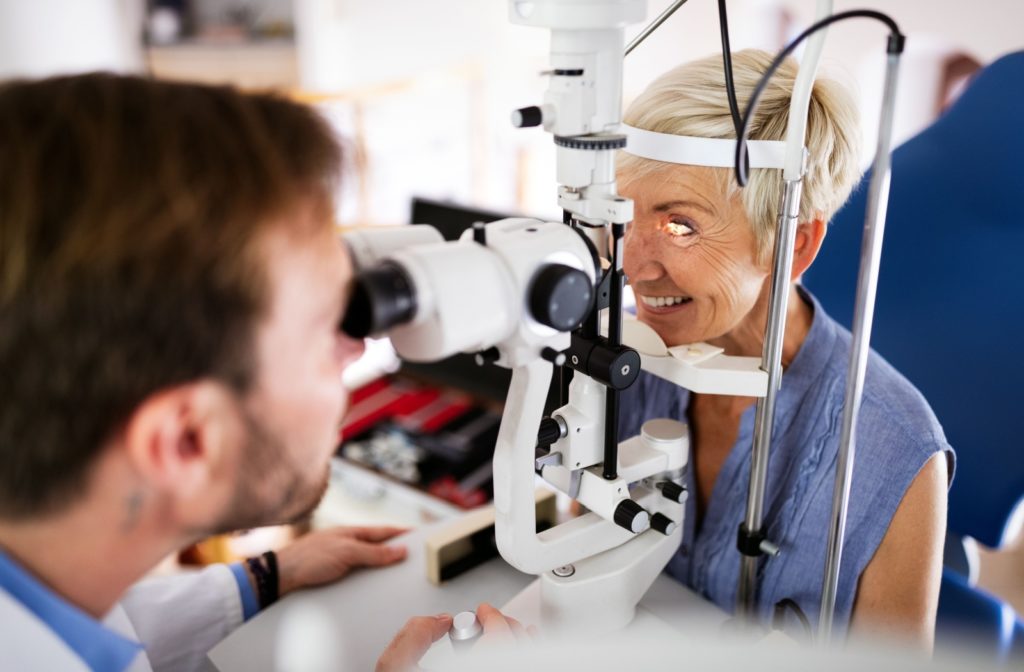Understanding the nuances between different conditions can be a game-changer for safeguarding your eye health. Glaucoma and ocular hypertension are two such interconnected conditions, both having to do with increased intraocular pressure (IOP).
The main difference between glaucoma and ocular hypertension is damage to the optic nerve. If you have increased eye pressure without any other glaucoma symptoms, such as vision loss, then you have ocular hypertension. However, ocular hypertension can indicate you’re at risk of developing glaucoma and you must get regular eye exams to monitor any changes.
Understanding Glaucoma
Glaucoma is often referred to as the “silent thief of sight,” primarily because it can progress unnoticed until it significantly affects vision. It’s not a single condition, but rather a group of eye diseases that damage the optic nerve. The optic nerve attaches to the retina and sends signals to the brain to translate light into images.
Damage to the optic nerve is typically caused by increased IOP. So, where does all this pressure come from? Your eyes aren’t empty orbs, they’re full of aqueous humor, a clear fluid your eyes produce constantly. This fluid should drain out of the eye through channels. If it doesn’t, your IOP rises, which could damage the optic nerve.
We say a high IOP “typically” causes glaucoma because there are several types with different relationships to eye pressure. The most common types are:
- Open-angle glaucoma: The most common form, where the eye doesn’t drain fluid as well as it should, but the drainage channel—called the angle—is open.
- Angle-closure glaucoma: A less common form where the eye’s drainage canals become blocked or covered over. This can lead to sudden, severe symptoms and rapid vision loss.
- Secondary glaucoma: Secondary glaucoma occurs as the result of another medical condition or injury that affects the eye’s drainage system.
- Normal-tension glaucoma: Normal-tension glaucoma occurs when the optic nerve is damaged despite normal IOP—which makes this type challenging to diagnose.
The tricky part about glaucoma is its sneakiness. For many types, there are often no symptoms in their early stages. As it progresses, you might notice loss of peripheral vision, or tunnel vision, but by then, the damage is significant and irreversible.
Understanding Ocular Hypertension
Think of ocular hypertension as high blood pressure inside your eye. If that sounds a lot like glaucoma, you’re right. The difference is the pressure in your eyes is higher than normal but without any noticeable damage to your vision or optic nerve.
Like its cousin glaucoma, ocular hypertension doesn’t wave red flags. You won’t feel it, and it won’t cloud your vision, making regular eye exams crucial for detection.
Ocular hypertension isn’t the same as glaucoma, but it puts you at an increased risk of developing the latter. Think of it as a little warning light telling you to get your eyes examined more frequently. If the pressure builds too much, it can eventually damage the optic nerve.

Diagnosing Glaucoma & Ocular Hypertension
Early detection is your best defense against both conditions. Start by recognizing your risk factors, as glaucoma and ocular hypertension share many of them, including:
- Age
- Family history of similar conditions
- Diabetes
- High blood pressure
- Steroid medication
- Eye injuries or surgery
With comprehensive eye exams, your optometrist can measure IOP, inspect the drainage angle, assess optic nerve damage, and test your peripheral vision.
Treatments & Management
While neither glaucoma nor ocular hypertension can be cured, their progression can be significantly slowed with proper treatment. Glaucoma treatment strategies vary depending on the type of glaucoma and your unique situation. The overall goal of each treatment is to reduce IOP and prevent damage to the optic nerve.
Prescription eye drops are a popular method. They attempt to lower eye pressure by either decreasing fluid production in the eyes or enhancing fluid drainage. You can supplement eye drops with oral medication if the pressure isn’t decreasing fast enough.
In very severe cases where your doctor needs to lower IOP fast, laser treatment offers a viable alternative. A surgeon uses a laser to make your eye’s drainage angle work better or create a tiny hole in the iris to give fluids a path out of the eye—depending on what type you have.
Surgery represents another option, with trabeculectomy being a common surgical approach. This technique involves cutting a flap so the fluid can drain out.
Living with Glaucoma & Ocular Hypertension
Being diagnosed with glaucoma or ocular hypertension might feel daunting, but with prompt treatments, many people live full and active lives. Regular check-ups and adherence to treatment plans are key.
By staying informed and proactive, you’re not just protecting your vision; you’re preserving your quality of life. If you’re at risk or it’s been a while since your last eye exam, don’t wait. Reach out to our Total Vision Pacific EyeCare team today and take an essential step toward safeguarding your sight.
Book your eye exam today!



